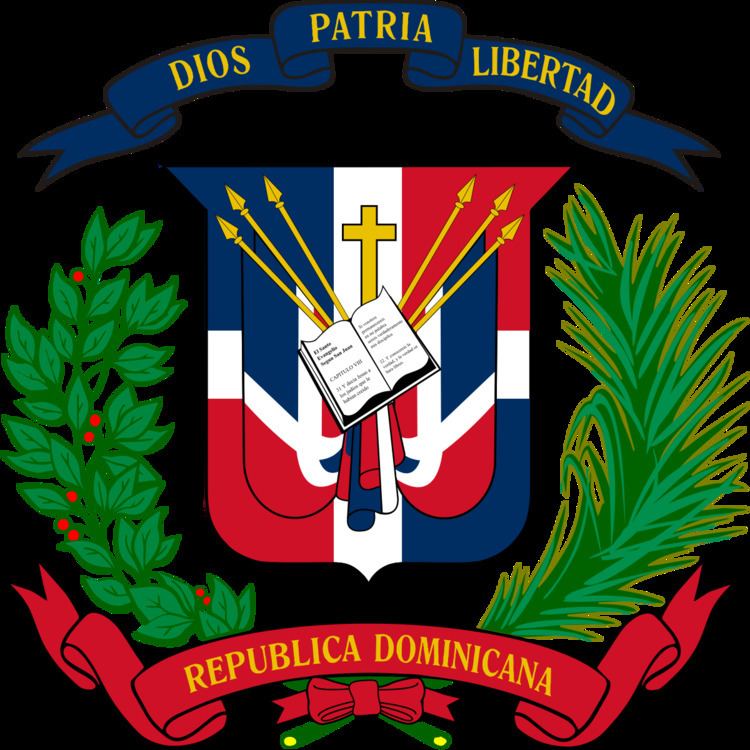20 May 2012 (2012-05-20) 2016 → 51.21% 46.95% | 2,323,150 2,129,997 | |
 | ||
Presidential elections were held in the Dominican Republic on 20 May 2012. They were the fifth quadrennial elections for the presidency and vice-presidency since 1998, when a change in the electoral law separated the presidential from the congressional and municipal elections.
Contents
As specified in the new constitution ratified in January 2010, the presidential elections of 2012 coincided with the election of Overseas Deputies in Dominican expatriate communities. Since 1974, elections in the Dominican Republic took place on 16 May every four years. Nevertheless, the constitutional reform of 2009 stipulated in article 209 that the elections would be held on 20 May 2012 to avoid their falling on a work day. Candidates for the presidency competed for the highest number of votes, with the leader needing more than 50% of valid ballots to avoid a second round.
Danilo Medina of the ruling Dominican Liberation Party was elected president with a majority of votes in the first ballot.
This was the first election to involve participation by Dominican citizens abroad. In addition to voting for the president and vice-president, Dominican expatriates participated in by-elections for seven new seats (within three overseas constituencies) in the Chamber of Deputies.
Background
In 2008, Leonel Fernández of the Dominican Liberation Party defeated candidates Miguel Vargas Maldonado of the Dominican Revolutionary Party; Amable Aristy Castro of the Social Christian Reformist Party; Eduardo Estrella of the Revolutionary Social Democratic Party; Trajano Santana of the Independent Revolutionary Party; Guillermo Moreno of the Movement for Independence, Unity and Change; and Pedro de Jesús Candelier of the Popular Alliance Party in the presidential elections, while the Dominican Liberation Party maintained a considerable majority in both houses of Congress. The main topics of the campaign of 2008 were the issue of reelection, the macroeconomic stability maintained by the Fernández government, and the alleged corruption which dominated the political landscape. The Santo Domingo Metro and other national matters were also important topics, especially during the final months of the campaign.
During Fernández's third presidential term several public works projects were carried out, a second line of the metro was opened, tourism grew, and free-trade zones were expanded. There was a constitutional reform, new judges were appointed to the Supreme Court, and the Electoral and Constitutional Tribunals were created. Several treaties were ratified, including seven bilateral accords with the government of Haiti on the Bolivarian Solidarity Fund to finance projects, border security, commerce, migration, health, the environment, and agriculture, as well as an accord with Colombia on air transport. Also passed was a law granting fiscal amnesty to all employers behind on their payments into the Social Security system; nonetheless, the attempt to apply it in its entirety failed.
In the congressional and municipal elections of 2010, the Dominican Liberation Party won the majority of representatives in both houses of Congress, while the Dominican Revolutionary Party only managed a few seats in the Chamber of Deputies and none in the Senate.
A 2011 poll found that the majority of Dominicans were unhappy with the government. Nevertheless, although many Dominicans believed that Fernández could lead them through the economic difficulties, they showed themselves to be dissatisfied with his program.
The internal crisis of the two main contending parties led to divisions within both of them, unleashing mutual defections among their members. The PRD was afflicted with the most complicated internal conflict. In spite of agreeing to campaign in a civil fashion in a resolution signed by both parties in March 2012, this was not observed and the parties pursued an aggressive campaign strategy.
Electorate
6.5 million Dominican voters were eligible to vote in the 2012 election. There were 14,470 polling places open for the election: 13,865 precincts were located within the Dominican Republic, while an additional 605 precincts were open overseas. Approximately 300,000 expatriates, making up around 5% of the total electorate, were eligible to vote abroad. The election board had set up official precincts for Dominicans voters living in the United States, Belgium, Canada, France, Germany, Italy, the Netherlands, Spain, Panama, Switzerland and Venezuela. More than 100,000 of the eligible voters resided in the U.S. state of New York.
Political parties
A total of 24 political parties were represented on the electoral ballot, including the two large parties and 22 small parties. The small parties are those which do not receive more than 10% of the vote and which are clearly not directly rivaling the main candidates. These parties generally choose to ally themselves with one of the large parties. Thirteen parties were previously rejected by the Central Electoral Commission.
Allies:
Allies:
Primary elections
The Dominican Liberation Party and Dominican Revolutionary Party held primary elections with the following results.
Notas
Candidates
Six candidates ran in the election, with former president Hipólito Mejía of the Dominican Revolutionary Party (PRD) and ex-parliamentarian Danilo Medina of the ruling Dominican Liberation Party (PLD) being considered most likely to win. Mejía and Medina had already faced each other in the 2000 election. The constitution barred incumbent president Leonel Fernández of the PLD from running for a third term.
Reactions
After the PLD declared victory, supporters of Mejía complained about cases of fraud, including vote-buying, and announced to contest the result. Mejía refused to concede to Medina and doubted the result. The PRD representative on the Central Electoral Commission claimed that the official result reflected much less votes than Mejía should have had received, and indicated that the head of the commission was a partisan of the PLD. Amid an overall orderly electoral process, there were some reports of adherents of both major parties offering money to voters in exchange for voting for their candidate or for passing their vote cards. Incidents of vote-buying were confirmed by the observers from the Organisation of American States (OAS), headed by Uruguay's ex-president Tabare Vazquez. However, they considered the cases not sufficient to distort the overall result, and described the election by and large as "successful".
